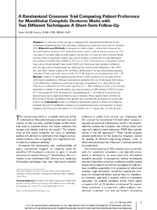A Randomized Crossover Trial Comparing Patient preference for Mandibular Complete Dentures Made with Two Different Techniques: A Short-Term Follow-Up
Abstract
Purpose: The objective of this trial was to compare short-term patient preference for two mandibular complete denture (CD) fabrication techniques: neutral zone (NZ) and conventional (CV).
Materials and Methods. A prospective, within-subject, randomized crossover trial was performed on a sample of 37 edentulous patients with CD experience. Two new sets of CDs were made for each patient, one set with a CV and one with a NZ mandibular denture. After consecutively wearing each set for at least 2 months after the last adjustment visit, patients indicated preference (CV, NZ or none). Associations and comparisons were made using the generalized linear model (GLM) and Fisher exact test between preference and sex, age, period of edentulousness, tissue quality, prosthodontic diagnostic index (PDI) and oral health-related quality of life (OHRQoL) differences of the two interventions assessed using the 20-item oral health impact profile (OHIP-20). Significance level was determined at P= .05.
Results. A total of 15 (40%) patients preferred NZ, 8 (22%) preferred CV dentures and 14 (38%) had no preference. Although more women preferred NZ over CV dentures (50% versus 27%), difference in preference according to sex was not significant (P= .359). Neither was difference in preference and PDI scores significant (P= .603). Preference could not be strongly associated to period of edentulousness, age, tissue scores and differences in OHIP-20 scores (P> .05), except for OHIP-20 scores and NZ preference (P< .001). Better fit, comfort and eating were reasons why patients preferred a type of denture. These reasons were identified for both types of denture. Appearance and speech were not identified as reasons for a particular preference.
Conclusions. Based on preference expressed by patients, there is no difference between NZ and CV mandibular dentures. Denture preference could not be related to patient variables over the study’s time frame.

